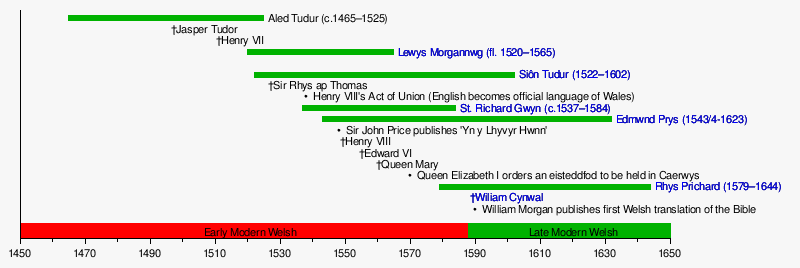
The Kingdom of Gwynedd was a Welsh kingdom and a Roman Empire successor state that emerged in sub-Roman Britain in the 5th century during the Anglo-Saxon settlement of Britain.

The Oxford Book of Welsh Verse in English was a 1977 poetry anthology edited by the author and academic Gwyn Jones. It covered both Welsh language poetry, in English translation, and Welsh poets writing in English.
Medieval Welsh literature is the literature written in the Welsh language during the Middle Ages. This includes material starting from the 5th century AD, when Welsh was in the process of becoming distinct from Common Brittonic, and continuing to the works of the 16th century.
Dafydd is a Welsh masculine given name, related to David, and more rarely a surname. People so named include:
Ednyfed Fychan, full name Ednyfed Fychan ap Cynwrig, was a Welsh warrior who became Seneschal to the Kingdom of Gwynedd in Northern Wales, serving Llywelyn the Great and his son Dafydd ap Llywelyn. Fychan claimed descent from Marchudd ap Cynan, Lord of Rhos, 'protector' of Rhodri Mawr, King of Gwynedd. He was the ancestor of Owen Tudor and thereby of the Tudor dynasty.
Cynddelw Brydydd Mawr, was the court poet of Madog ap Maredudd, Owain Gwynedd, and Dafydd ab Owain Gwynedd, and one of the most prominent Welsh poets of the 12th century.
Gruffudd Leiaf was a 15th-century Welsh poet, known almost exclusively from his works. He was reputed to descend from the royal family of Gwynedd.
Dafydd ap Edmwnd was one of the most prominent Welsh language poets of the Later Middle Ages.
Iorwerth Beli was a poet who wrote in the Middle Welsh language. Very little is known of his life.
Gwilym ab Ieuan Hen was a Welsh-language poet during the time of the Beirdd yr Uchelwyr, the professional "Poets of the Nobility".
Maredudd ap Rhys, also spelt Meredudd ap Rhys, was a Welsh language poet and priest from Powys. He was born in gentry, having pedigree blood, as discovered from the Peniarth Manuscripts. He is thought to have been the bardic tutor to Dafydd ab Edmwnd, and thus won distinction both as a poet and as a poetry teacher.

Tudur Penllyn was a Welsh language poet during the time of the Beirdd yr Uchelwyr, the professional poets of the late Middle Ages.
Einion Offeiriad was a Welsh language poet and grammarian.

Anwyl of Tywyn are a Welsh family who claim a patrilinear descent from Owain Gwynedd, King of Gwynedd from 1137 to 1170 and a scion of the royal House of Aberffraw. The family motto is: Eryr eryrod Eryri, which translates as "The Eagle of the Eagles of Snowdonia. The family lives in Gwynedd and speak Welsh.

Ieuan Deulwyn was a Welsh language poet or bard.
Alis ferch Gruffudd ab Ieuan ap Llywelyn Fychan or Alis Wen was a 16th-century poet who wrote in Welsh. She wrote several englynion on matters of her personal and family life, and a cywydd aimed at reconciling two men.
Ieuan ap Gruffudd Leiaf was a Welsh uchelwr and bard, the son of poet Gruffudd Leiaf. His poetry, spanning the period c.1420 to c. 1470, has been fully edited. The earliest dateable poem that can be confidently assigned to him are a cywydd in praise of Gwilym ap Gruffudd ap Gwilym ap Gruffudd ap Heilin and his newly built home, Y Penrhyn, Llandygái. The context of this poem seems to be the tradition of the'cyff clêr', with Ieuan, a 'prifardd', answering the taunts of lesser bards. Rhys Goch Eryri was present at the celebration and composed a perhaps more well-known praise poem to Y Penrhyn and its owner. Shortly after this, Ieuan composed a cywydd satiring the River Llugwy, into which the poet fell on his way to Y Penrhyn one Christmas. A cywydd to Saint Anna, mother of the Virgin Mary and two other daughters also named Mary, attributed to Ieuan in the only manuscript in which it survives, could also be from the same period or earlier.
Sir Rhys ap Gruffydd or Rhys ap Gruffudd, also known as 'Syr Rhys', Rhys Hen or Rhys Griffith, was the wealthiest nobleman in 14th-century Wales. He was the most prominent of the native supporters of the English kings during this early period of English settlement in Wales.
Gruffudd ap Maredudd ap Dafydd was a Welsh bard working in Anglesey in the service of the Tudors of Penmynydd. One of the last of the older school of poets known as the Gogynfeirdd, he resisted the innovations in Welsh verse-form which took place in his lifetime. About 2400 lines of his work have survived in the Red Book of Hergest. His best-known poem is "Gwenhwyfar", an elegy to a young lady. He was described by the literary historian D. Myrddin Lloyd as "the finest of all the late Gogynfeirdd poets" and by Saunders Lewis as "one of the greats".
"The Snow" is a 14th- or 15th-century Welsh-language poem in the form of a cywydd evoking a landscape which, to the poet's chagrin, is covered with snow. It has been described as an imaginative tour de force. Manuscripts of the poem mostly attribute it to Dafydd ap Gwilym, widely seen as the greatest of the Welsh poets, though some name Dafydd ab Edmwnd or Ieuan ap Rhys ap Llywelyn as the author. Modern literary historians have differed as to whether it is indeed by Dafydd ap Gwilym, but the two most recent editions of his poems have rejected it. The poem has nevertheless remained popular with translators and it continues to appear in anthologies, including Thomas Parry's own Oxford Book of Welsh Verse and Gwyn Jones's Oxford Book of Welsh Verse in English.








